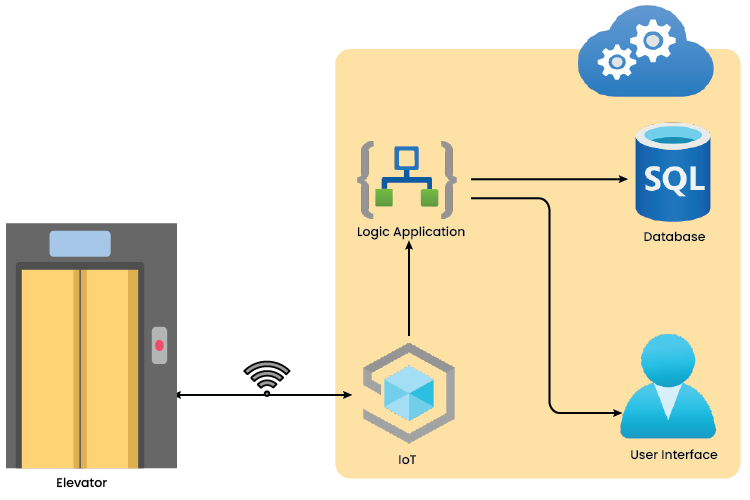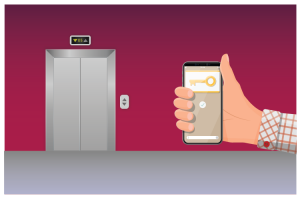Today’s rapidly advancing technological environment, the Internet of Things (IoT) has emerged as a revolutionary in various industries, transforming the way we interact with our surroundings. One area where IoT is making significant progress is in the realm of smart elevator systems. Elevators, once considered mere means of transportation within buildings, are now transforming into intelligent and interconnected systems. By integrating IoT technologies, elevators are becoming more efficient, secure and convenient than ever before.
In this blog, we will explore essential components, key features and capabilities of IoT elevator systems and types of smart elevator technology that are reshaping urban infrastructure.
Essential Components of IoT enabled Elevator System
A smart elevator system consists of several essential components that work together to enable advanced functionality and enhance the overall elevator experience. Here are the key components:
Elevator Control Unit: The Elevator Control Unit (ECU) holds a key role within a smart elevator system, functioning as the system’s cognitive center. Utilizing data in real-time from various sensors, the ECU employs advanced algorithms to choreograph responsive decisions, aiming to enhance the elevator’s efficiency and elevate the user experience. For instance, based on data from occupancy sensors, traffic patterns and energy consumption metrics, the ECU can intelligently adjust elevator routes in a way that minimizes waiting times, conserves energy, and ensures smooth traffic flow, thereby transforming the elevator journey into an efficient, tailored and user-centric experience.
Sensors: Advanced sensor networks that enable real-time data collection and analysis within elevator systems. Variety of sensors can be integrated such as motion, proximity, pressure, and environmental sensors, ensuring accurate and reliable data acquisition. Customized sensor solutions not only enhance elevator safety by monitoring parameters like movement and load but also contribute to predictive maintenance strategies, optimizing elevator performance and reducing downtime through data-driven insights.
Actuators: Actuators in a smart elevator system serve as the responsive limbs, executing precise actions based on the system’s intelligence. For instance, when the central control unit detects a passenger’s desired floor, actuators seamlessly guide the elevator car to the destination with smooth acceleration and deceleration, enhancing passenger comfort.
Network Connectivity : Smart elevators require connectivity to transmit data between different components and enable communication with external systems. For instance, using wireless protocols like Utilizing Wi-Fi, Bluetooth or other connectivity enables real-time data transfer between sensors and control units, regardless of the elevator’s location within the building. This connectivity empowers elevators to be monitored, controlled and managed remotely, leading to improved efficiency, reduced downtime and proactive maintenance strategies.
Why Moving Towards a Smart Elevator Solution is a Good Move?
A smart elevator utilizes various forms of connectivity for control and monitoring. Internally, the elevator connects with custom hardware, which can be through Wi-Fi or LAN interface. Communication with the elevator controller occurs via GPIO pin or UART. The hardware provisions itself to IoT central and sends signals, such as changes in GPIO pin or register values, to the IoT central. Any signal change detected by the hardware is transmitted to the IoT central. From there, IoT central exports the data to the logic application layer, where it is processed to generate meaningful signals, fault predictions, and fault detections. Finally, these outputs are sent to the user interface through WebSocket technology.
The next-generation smart elevator is proving to be more efficient than the traditional elevators. We used to do the maintenance testing, track the records, status and check the elevators manually. That was too time-consuming and cost-effective. There are multiple benefits of using a connected elevator solutions, let us understood by discussing the smart elevator technology use-cases in brief:
Avoid Unauthorized Access: The IoT enabled elevator employs a secure access system to ensure only authorized individuals can use it to reach their destination. To gain entry, people must have either fingerprint access or a smart card. The elevator is equipped with a fingerprint sensor or smart card reader, connected through an RS232 DB9 connector, and data is shared using UART. The PSOC6 hardware reads the register data using the Modbus protocol and transfers this information to an IoT-enabled public cloud, such as AWS or Azure. This process allows the smart elevator to verify the identity of users and permit only authorized individuals to access its services.
Predict Destination: The system utilizes Artificial Intelligence (AI) to predict user behavior. The system employs facial recognition to identify users and sends their information to the IoT-enabled cloud. The cloud checks the user’s authorization and applies a Machine Learning (ML) algorithm to determine the user’s intended destination floor. In cases where the user has visited multiple floors earlier, the elevator communicates with the user using the VoIP protocol, prompting the user to provide their desired arrival floor using voice commands. This innovative approach enhances the smart elevator’s capabilities, making it more user-friendly and intuitive.
Benefits of Adopting Smart Elevator Solutions
Using smart elevator solutions brings significant advantages that transform vertical movement and building control. These benefits include multiple benefits from user and operational level. Let’s explore the key advantages of adopting smart elevator technology:
Maintenance Prediction: A fault is an anomaly generated based on the I/O pin or register value of the elevator. Based on the GPIO pin and generated fault ML model will predict the level of maintenance and decide at which part of the elevator maintenance is required. When the GPIO pin changes, it will run on the cloud’s logic and generate meaningful data like elevator status and faults.
Live Elevator Monitoring: Elevators have some changeable information like elevator direction, elevator state, elevator current position, elevator door current status, etc. With a smart elevator, sending a signal to the IoT central and at the same time an IoT central signal to the elevator, a piece of meaningful information will be generated. That information will be updated live on the user interface so that the user can monitor the elevator at their end & remote location; the user can also track the elevator status and the fault which exists in the elevator.
Remote Controlling: At some level, if the user needs to pass some commands to the elevator like start-stop the elevator at a specific duration, mainline switch on/off, or run some engine rules on the elevator, based on the user command, the elevator will perform by using the IoT central command. Here, it saves man-power and time to check or do things manually.
Remote Testing: As earlier mentioned, faults will be identified using the GPIO pin, so based on that list of faults and GPIO value, the elevator technician can debug the elevator issues remotely. With GPIO pin testing value, it will be performed and can be debugged by changing the elevator’s active high value remotely, so the technician can remotely identify the elevator failure causes.
Cost-Effective: As we know, the cost of the elevator technician will be very high, using the IoT central elevator can be remotely operated and tested so that the technician cost can be leveraged at some level. According to the scenario, the user can set the rules like the usage of the elevator at a specific time or use only some main elevators, etc. which leads to power consumption reduction.
Zero Downtime: Elevator downtime can be negligible if we have such fault detection techniques. The user can also figure out the power failure from the elevator controller with the help of IoT and can specify the rule engine on the power failure that will start the elevator on the backup power. Users can also track the timeout of the backup power as well, so by utilizing that rule elevator downtime can be reduced.
Touchless Controls: Implementing touchless elevator controls and touchless elevator buttons can help property owners and building managers in lessen the spread of bacteria and diseases. By integrating these features with contactless access solutions and building management tools, individuals can navigate the building without the need to touch buttons or door handles, reducing the risk of spreading illnesses through contact. This combined approach enhances hygiene and minimizes the potential for disease transmission within the building.
Smart Floor Management: By utilizing the power of algorithms and sensors, these innovative systems optimize elevator movement by cleverly grouping passengers with similar destinations together. The result? Reduced travel time and improved overall efficiency. For example, an office building’s smart elevator system can analyze employee destination patterns throughout the day and assign elevator cars to minimize wait times and congestion.
Advanced Security and Access Control: In IoT enabled Elevator, upgraded security features such as biometric access control, facial recognition and RFID authentication are seamlessly integrated, ensuring prevention of unauthorized access to restricted areas or specific floors. For instance, a residential smart elevator system can use biometric authentication to grant residents access to their designated floors while preventing unauthorized individuals from entering.
What are the Types of Smart Elevator Technology ?
IoT technology has transformed elevators beyond their traditional roles as an instrument of vertical mobility.There are various types of connected elevator solutions technologies that are transforming overall user experience. Here are a few examples:
Mobile Credential Based Smart Elevators: IoT enabled elevator technology replaces traditional physical controls with a wireless system accessed through smartphones. Users like staff, residents and guests receive unique mobile credentials via a dedicated app. By interacting with control panel readers, the app enables touch-free elevator selection and operation. Residents can request an elevator by holding their device to a lobby reader, select a floor via the app and be directed to the nearest available cabin. Security teams manage user permissions and secure specific floors for privacy.

Touchless Elevators: As an alternative to smartphone-based smart elevator technology, touchless elevator buttons are being implemented in some installations. These buttons replace traditional mechanical call buttons inside elevator cabins with motion sensors that detect hand gestures. Authorized users can simply position their finger in front of the sensor to interact with the controls and select a floor. These touchless buttons can also be used manually or integrated with smartphone controls for added convenience.
About VOLANSYS
VOLANSYS has established itself as an expert in designing and developing a complete IoT solution and transforming legacy systems into smart ones. We have worked on an elevator project where our client wanted to design a more cost-effective smart elevator solution to effectively manage sensors such as fire, accelerometer and lift door sensors without compromising the performance of the solution.

About the Author: Pratik Gondaliya
Pratik Gondaliya is associated with VOLANSYS Technologies as Sr. Software Engineer. He has 6+ years of experience working on IoT-based projects which include real-time device analytics over the cloud, device monitoring, rule engine. He also has experience working on video streaming protocol in providing live streaming and archival streaming.









